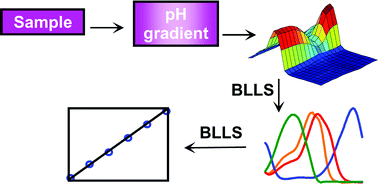This article reports on the first application of a modified version of the bilinear least-squares model to absorbance-pH second-order data recorded for complex samples. The latter are composed of fruit drink powders, where four different analytes and additional background components occur. The analytes are the common juice colorants tartrazine, yellow sunset, allura red and indigo carmine. The data have been measured after generating a double pH gradient within a flow injection system. The selected chemometric methodology adequately exploits the second-order advantage, needed to take into account the background interferents present in real samples. Due to severe spectral overlapping between the acid and basic forms of each of the colorants in the working pH range, other second-order multivariate calibration methods such as parallel factor analysis and multivariate curve resolution-alternating least-squares could not be successfully applied to the presently studied samples. Recoveries of 94.8, 104.7, 109.3 and 105.3% were obtained for yellow sunset, indigo carmine, allura red and tartrazine respectively in the real test samples.

You have access to this article
 Please wait while we load your content...
Something went wrong. Try again?
Please wait while we load your content...
Something went wrong. Try again?


 Please wait while we load your content...
Please wait while we load your content...